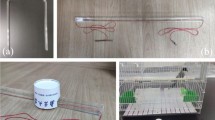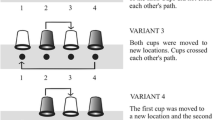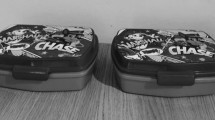Abstract
Object permanence, the ability to mentally represent objects that have disappeared from view, should be advantageous to animals in their interaction with the natural world. The objective of this study was to examine whether lemurs possess object permanence. Thirteen adult subjects representing four species of diurnal lemur (Eulemur fulvus rufus, Eulemur mongoz, Lemur catta and Hapalemur griseus) were presented with seven standard Piagetian visible and invisible object displacement tests, plus one single visible test where the subject had to wait predetermined times before allowed to search, and two invisible tests where each hiding place was made visually unique. In all visible tests lemurs were able to find an object that had been in clear view before being hidden. However, when lemurs were not allowed to search for up to 25-s, performance declined with increasing time-delay. Subjects did not outperform chance on any invisible displacements regardless of whether hiding places were visually uniform or unique, therefore the upper limit of object permanence observed was Stage 5b. Lemur species in this study eat stationary foods and are not subject to stalking predators, thus Stage 5 object permanence is probably sufficient to solve most problems encountered in the wild.


Similar content being viewed by others
References
Bjork EL, Cummings EM (1981) Search on a five choice invisible displacement task: a rejoinder to Schuberth and Gratch. Infant Behav Dev 4:65–67
Call J (2001) Object permanence in orangutans (Pongo pygmaeus), chimpanzees (Pan troglodytes), and children (Homo sapiens). J Comp Psychol 115(2):159–171
Collier-Baker E, Davis JM, Suddendorf T (2004) Do dogs (Canis familiaris) understand invisible displacement? J Comp Psychol 118(4):421–433
Collier-Baker E, Davis JM, Nielson M, Suddendorf T (2006) Do chimpanzees (Pan troglodytes) understand single invisible displacement? Anim Cogn 9:55–61
Cooper HM (1978) Learning in prosimians: recent advances in primatology. Academic Press, New York, pp 941–943
de Blois ST, Novak MA (1994) Object permanence in rhesus monkeys (Macaca mulatta). J Comp Psychol 108:318–327
de Blois ST, Novak MA, Bond M (1998) Object permanence in orangutans (Pongo pygmaeus) and squirrel monkeys (Saimiri sciureus). J Comp Psychol 112:137–152
Diamond A (1991) Neuropsychological insights into the meaning of object concept development. In: Carey S, Gelman R (eds) The epigenesis of the mind: essays on biology and cognition. Erlbaum, Hillsdale, NJ, pp 67–110
Dore FY (1986) Object permanence in adult cats (Felis catus). J Comp Psychol 100:340–347
Dore FY, Dumas C (1987) Psychology of Anim Cogn: Piagetian studies. Psychol Bull 102:219–233
Dumas C (1992) Object permanence in cats (Felis catus): an ecological approach to the study of invisible displacements. J Comp Psychol 106:404–410
Ehrlich E, Fobes JL, King JE (1976) Prosimian learning capacities. J Hum Evol 5:599–617
Etienne AS (1973) Searching behavior towards a disappearing prey in the domestic chick as affected by preliminary experience. Anim Behav 21:749–761
Fiset S, Dore FY (2006) Duration of cats’ (Felis catus) working memory for disappearing objects. Anim Cogn 9:62–70
Fiset S, LeBlanc V (2007) Invisible displacement understanding in domestic dogs (Canis familiaris): the role of visual cues in search behavior. Anim Cogn 10:211–224
Fiset S, Beaulieu C, Landry F (2003) Duration of dogs’ (Canis familiaris) working memory in search for disappearing objects. Anim Cogn 6:1–10
Fleagle JG (1999) Primate adaptation and evolution. Academic Press, San Diego
Funk MS (1996) Development of object permanence in the New Zealand parakeet (Cyanoramphus auriceps). Anim Learn Beh 24(4):375–383
Gagnon S, Dore FY (1992) Search behavior in various breeds of adult dogs (Canis familiaris): object permanence and olfactory cues. J Comp Psychol 106:58–68
Glickman SE, Clayton K, Schiff B, Guritz D, Messe L (1965) Discrimination learning in some primitive mammals. J Genet Psychol 106:325–335
Goodman SM (2003) Predation on lemurs. In: Goodman SM, Benstead JP (eds) The natural history of Madagascar. University of Chicago Press, Chicago, pp 1221–1228
Grassi C (2006) Variability in habitat, diet and social structure of Hapalemur griseus in Ranomafana National Park, Madagascar. Am J Phys Anth 131(1):50–63
Gratch G, Apple KJ, Evans WF, LeCompte GK, Wright NA (1974) Piaget’s stage IV object concept error: evidence for forgetting or object conception? Child Dev 45:71–77
Gruber HE, Girgus JS (1971) The development of object permanence in the cat. Dev Psychol 4:9–15
Hare B, Brown M, Williamson C, Tomasello M (2002) The domestication of social cognition in dogs. Science 298:1634–1636
Harris PL (1973) Preservative errors in search by young infants. Child Dev 44:28–33
Hauser MD (2001) Searching for food in the wild: a nonhuman primate’s expectations about invisible displacements. Dev Sci 4:84–93
Hood BM, Hauser MD, Anderson L, Santos L (1999) Gravity biases in a non-human primate? Dev Sci 2(1):35–41
Hosey GR (1997) Drinking from tails: social learning of a novel behaviour in a group of ring-tailed lemurs (Lemur catta). Primates 38:415–422
Jolly A (1964) Prosimian’s manipulation of simple object problems. Anim Behav 12:560–570
Jolly A (2003) Lemur catta, ring-tailed lemur, maky. In: Goodman SM, Benstead JP (eds) The natural history of Madagascar. University of Chicago Press, Chicago, pp 1229–1231
Karpanty S, Wright PC (2006) Multiple predators on lemurs in the rainforest of Madagascar: observations and experiments. In: Gursky S, Nekaris KA (eds) Primates and their predators. Erlbaum, Hillsdale, NJ, pp 67–110
Lewis KO, Jaffe S, Brannon EM (2005) Analog number representations in mongoose lemurs (Eulemur mongoz): evidence from a search task. Anim Cogn 8:247–252
Mac Donald SE, Pang JC, Gibeault S (1994) Marmoset (Callithrix jacchus jacchus) spatial memory in a foraging task: Win-stay versus win-shift strategies. J Comp Psychol 108:328–334
Maslow AH, Harlow HF (1932) Comparative behaviour of primates: II. Delayed reaction tests on primates at Bronx Park Zoo. J Comp Psychol 14:97–107
Mathieu M, Bouchard MA, Granger L, Herscovitch J (1976) Piagetian object-permanence in Cebus capucinus, Lagothrica flavicauda and Pan troglodytes. Anim Behav 24:585–588
Mendes N, Huber L (2004) Object permanence in common marmosets (Callithrix jacchus). J Comp Psychol 118:103–112
Natale F (1989) Stage 5 object-concept. In: Antinucci F (ed) Cognitive structure and development in nonhuman primates. Erlbaum, New Jersey, pp 89–95
Natale F, Antinucci F, Spinozzi G, Poti P (1986) Stage 6 object concept in nonhuman primate cognition: a comparison between gorilla (Gorilla gorilla gorilla) and Japanese macaque (Macaca fuscata). J Comp Psychol 100:335–339
Neiworth JJ, Steinmark E, Basile BM, Wonders R, Steely F, DeHart C (2003) A test of object permanence in a new-world monkey species, cotton top tamarins (Saguinus oedipus). Anim Cogn 6:27–37
Overdorff DJ, Johnson S (2003) Eulemurs, true lemurs. In: Goodman SM, Benstead JP (eds) The natural history of Madagascar. University of Chicago Press, Chicago, pp 1320–1324
Pepperberg IM (2002) The value of the Piagetian framework for comparative cognitive studies. Anim Cogn 5:177–182
Pepperberg IM, Kozak F (1986) Object permanence in the African grey parrot (Psittacus erithacus). Anim Learn Behav 14:322–330
Pepperberg IM, Funk MS (1990) Object permanence in four species of psittacine birds. Anim Learn Behav 18:97–108
Pepperberg IM, Willner MR, Gravitz LB (1997) Development of Piagetian object permanence in a grey parrot (Psittacus erithacus). J Comp Psychol 111:63–75
Piaget J (1937/1954) The construction of reality in the child. Basic Books, New York
Redshaw M (1978) Cognitive development in human and gorilla infants. J Hum Evol 7:133–141
Santos LR, Mahajan N, Barnes JL (2005a) How prosimian primates represent tools: experiments with two species (Eulemur fulvus and Lemur catta). J Comp Psychol 119:394–403
Santos LR, Barnes JL, Mahajan N (2005b) Expectations about numerical events in four lemur species Eulemur fulvus, Eulemur mongoz, Lemur catta and Varecia rubra. Anim Cogn 8:253–262
Schino G, Spinozzi G, Berlingeur L (1990) Object concept and mental representation in Cebus apella and Macaca fascicularis. Primates 31:537–544
Siegler RS (1986) Children’s thinking. Prentice Hall, New Jersey
Tomasello M, Call J (1997) Primate cognition. Oxford University Press, New York
Triana E, Pasnak R (1981) Object permanence in cats and dogs. Anim Learn Behav 9:135–139
Vaughter RM, Smotherman W, Ordy JM (1972) Development of object permanence in an infant squirrel monkey. Dev Psychol 7:34–38
Voessing A (1987) Arbeitsteilige und kooperatives Problemloeseverhalten in Primatengruppen. Zool Beitr 31:305–340
Wise KL, Wise LA, Zimmermann RR (1974) Piagetian object permanence in the infant rhesus monkey. Dev Psychol 10:429–437
Wood S, Moriarty KM, Gardener BT, Gardener RA (1980) Object permanence in child and chimpanzee. Anim Learn Behav 8:3–9
Acknowledgments
The authors thank Penelope Bodry-Saunders and the Board of Directors of the Lemur Conservation Foundation in Myakka City, Florida, for allowing access to the lemurs and especially Brian Grossi for his assistance. At Eckerd College we thank Dr. Jim MacDougall and Dr. Peter Meylan. We greatly acknowledge Dr. John Robinson at Stony Brook University for his contributions and support. We thank the editor and four anonymous reviewers for thoughtful comments that greatly improved this paper. This study was approved by the Lemur Conservation Foundation Institutional Animal Care and Use Committee and conforms to federal guidelines for the use of animals in research.
Author information
Authors and Affiliations
Corresponding author
Rights and permissions
About this article
Cite this article
Deppe, A.M., Wright, P.C. & Szelistowski, W.A. Object permanence in lemurs. Anim Cogn 12, 381–388 (2009). https://doi.org/10.1007/s10071-008-0197-5
Received:
Revised:
Accepted:
Published:
Issue Date:
DOI: https://doi.org/10.1007/s10071-008-0197-5




